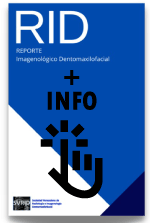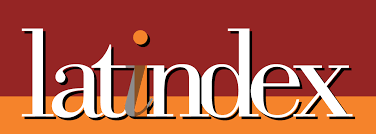Craniofacial radiographic featuresof ectodermal dysplasia. Case report
DOI:
https://doi.org/10.60094/RID.20230101-21Keywords:
Ectodermal Dysplasia, dental radiography, case reportsAbstract
Ectodermal dysplasia (ED) is a group of disorders which affect structures of ectodermal origin, where hypoplasia or aplasia of the tissues is observed. The most common phenotypes are hypohidrotic and hydrotic. The most prevalent is hypohidrotic ED and is caused by mutations in EDA1 gene on the X chromosome. Clinical features of hypohidrotic ED include hypohidrosis, hypotrichosis, and hypodontia. Hydrotic ED clinically presents hypotrichosis, nail dystrophy, and palmoplantar hyperkeratosis. At the intraoral level, hypohidrotic ED shows dental anomalies of shape and number, with an enamel more prone to caries and mechanical damage. Also, there may be atrophic inflammation of the mucosa, xerostomy, and sometimes dysphagia. Among the radiographic signs, dental anomalies and atrophy of alveolar processes are observed. A 14-year-old male patient with ED attends to the Faculty of Dentistry of the University of Talca for a clinical evaluation. Panoramic radiography showed the absence of multiple teeth, alteration of coronary and root shape in the teeth. Lateral cephalometric radiography showed atrophy of the alveolar process both in maxilla and mandible, decreased lower third, mandibular retrusion and atrophy, maxillary retrusion and maxillary incisive proclination. While bi-dimensional imaging studies contribute to an adequate diagnosis, three-dimensional imaging studies facilitate planning and treatment in patients with ED. The severe facial and dental malformations of the present case affect the masticatory and aesthetic function causing the treatment to be complex, requiring a multidisciplinary approach.
Downloads
References
Reyes J, Mendoza MI, Garrido E, Méndez CF, Méndez AR, Pozo G. Hypohidrotic ectodermal dysplasia: clinical and molecular review. Int J Dermatol. 2018;57(8):965-72. http://doi.org/10.1111/ijd.14048.2
Celli D, Manente A, Grippaudo C, Cordaro M. Interceptive treatment in ectodermal dysplasia using an innovative orthodontic/prosthetic modular appliance. A case report with 10- year follow-up. Eur J Paediatr Dent. 2018;19(4):307-12. http://doi.org/10.23804/ejpd.2018.19.04.11
Wright JT, Fete M, Schneider H, Zinser M, Koster MI, Clarke AJ, et al. Ectodermal dysplasias: classification and organization by phenotype, genotype and molecular pathway. Am J Med Genet A. 2019;179(3):442-7. http://doi.org/10.1002/ajmg.a.61045
Chandravanshi SL. Hypohidrotic ectodermal dysplasia: a case report. Orbit. 2020; 39(4):298-301. http://doi.org/10.1186/s13256-019-2268-4
Dubey S, Bhoot M, Jain K. Hypohidrotic ectodermal dysplasia: a rare disorder with bilateral infantile glaucoma. J Glaucoma. 2019;28(4):58-60. http://doi.org/10.1097/IJG.0000000000001156
Kratochvilova L, Dostalova T, Schwarz M, Macek M Jr, Marek I, Malíková M, et al. Ectodermal dysplasia: important role of complex dental care in its interdisciplinary management. Eur J Paediatr Dent. 2022;23(2):140-6. http://doi.org/10.23804/ejpd.2022.23.02.12
Mellerio J, Greenblatt D. Hidrotic ectodermal dysplasia 2. 2005 [updated 2020]. In: Adam MP, et al, editors. GeneReviews®. Seattle (WA): University of Washington, Seattle; 1993-2022.
Shi X, Li D, Chen M, Liu Y, Yan Q, Yu X, et al. GJB6 mutation A88V for hidrotic ectodermal dysplasia in a Chinese family. Int J Dermatol. 2019;58(12):1462-5. http://doi.org/10.1111/ijd.14341
Cerezo M, Pérez A, Serna C, Vicente A, Martínez Y, Cabello I, et al. Orthodontic and dentofacial orthopedic treatments in patients with ectodermal dysplasia: a systematic review. Orphanet J Rare Dis. 2022;17(1):376. http://doi.org/10.1186/s13023-022-02533-0
Velazque L, Da Silva G. Displasia ectodérmica hipohidrótica: características clínicas y radiográficas. Rev Odont Mex. 2015;19(4):253-7. http://doi.org/10.1016/j.rodmex.2015.10.007
Liu Y, Tang C. Interdisciplinary treatment with implant-supported prostheses for an adolescent with ectodermal dysplasia: a clinical report. J Prosthet Dent. 2020; 123(5):655-60. http://doi.org/10.1016/j.prosdent.2019.07.006
Bohner L, Vinayahalingam S, Kleinheinz J, Hanisch M. Digital implant planning in patients with ectodermal dysplasia: clinical report. Int J Environ Res Public Health. 2022;1(3):1489. http://doi.org/10.3390/ijerph19031489
AlNuaimi R, Mansoor M. Prosthetic rehabilitation with fixed prosthesis of a 5-year-old child with hypohidrotic ectodermal dysplasia and oligodontia: a case report. J Med Case Rep. 2019;13(1):329. http://doi.org/10.1186/s13256-019-2268-4
Kamat D, Mahajan R, Chatterjee D, Yadav J, Kumar R, Dayal D, et al. Clinical and genetic characteristics of ectodermal dysplasia in four indian children. Indian J Dermatol. 2022;67(1):54-57. http://doi.org/10.4103/ijd.ijd_406_21
European Commission, Directorate-General for Energy. Cone beam CT for dental and maxillofacial radiology: evidence-based guidelines. Publications Office. 2012. https://data.europa.eu/doi/10.2768/21874
Published
How to Cite
Issue
Section
License
Copyright (c) 2023 Reporte Imagenológico Dentomaxilofacial

This work is licensed under a Creative Commons Attribution 4.0 International License.
This work is licensed under a Creative Commons Attribution 4.0 International License.
AUTHORS RETAIN THEIR RIGHTS:
You are free to:
- Share: copy and redistribute the material in any medium or format for any purpose, including commercially.
Adapt: remix, transform and build upon the material for any purpose, including commercially.
The licensor cannot revoke these freedoms as long as you follow the terms of the license under the following terms:
- Attribution : you must give proper credit , provide a link to the license, and indicate if changes have been made. You may do so in any reasonable manner, but not in such a way as to suggest that you or your use is supported by the licensor.
- No additional restrictions: you may not apply legal terms or technological measures that legally restrict others from making any use permitted by the license.











